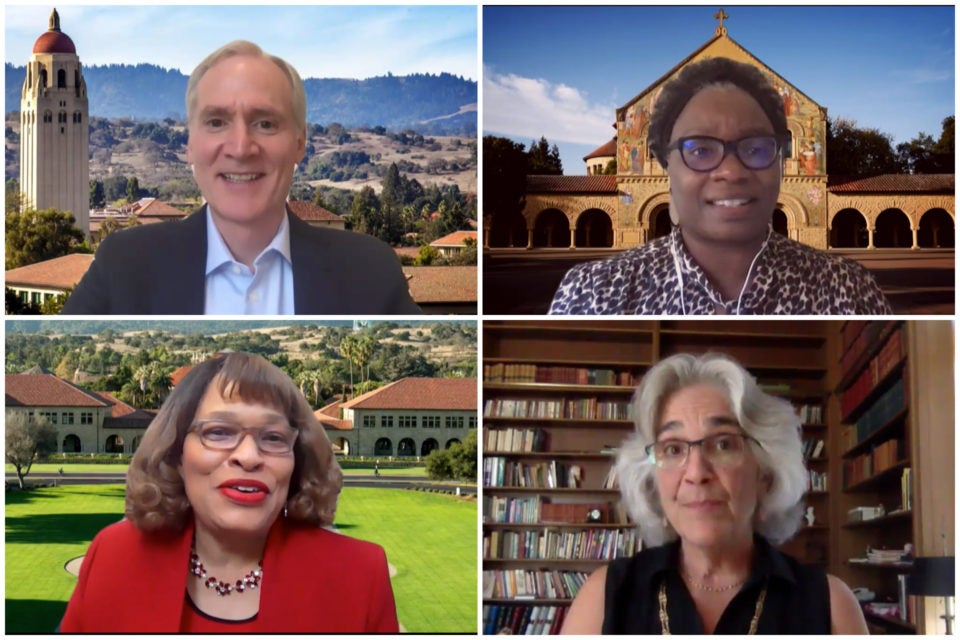Supporting students during the pandemic

In recent remarks to the Stanford community, Shirley Everett, senior associate vice provost for Residential & Dining Enterprises (R&DE), offered a glimpse of what life is like for the about 6,000 graduate and undergraduate students, postdoctoral scholars and residential staff Stanford is housing this quarter.
“To prevent the spread of the virus, face coverings, handwashing, temperature checks and physical distancing – to protect students and staff – are required at all R&DE locations,” Everett said, speaking during the first remote Campus Conversation of the new academic year.
Everett said the undergraduate students housed on campus are living together in one building in the new Escondido Village Graduate Residences – to ensure physical distancing and to help students create a robust and connected community.
The Campus Conversation, which focused on how Stanford is supporting student life during the pandemic, also featured talks by President Marc Tessier-Lavigne, Provost Persis Drell and Mona Hicks, senior associate vice provost and dean of students.
Stanford’s focus on student well-being includes both those living on campus and those learning remotely, Hicks said. The Office of Student Affairs is devoted to centering and co-creating connections and spaces to ensure that all students have equitable access to opportunity and to fostering experiences in an environment that ensures everyone feels a firm and inviting sense of belonging, she said.
Other topics the four university leaders discussed during the hour-long event included new programs to advance racial justice initiatives, the student population living on campus, fall quarter enrollment, current plans for winter quarter and new health guidelines.
Social pods
Drell said preliminary numbers show that at Stanford enrolled 1,676 first-year and transfer students during fall quarter, compared with 1,701 last year at the same point in time. Among the undergraduates admitted to Stanford in 2020-21, she said that 378 first-year students and 14 transfer students have chosen to take a gap year.
Drell said that while enrollment data won’t be final until later in October, currently at the undergraduate level, Stanford has about 82 percent of last fall’s number of students enrolled full time, while another 9 percent are taking a “flex term” – a quarter, in addition to a student’s three quarters of full-time enrollment, when a student can take up to 5 units with no tuition charge.
Looking ahead to winter quarter, Drell said the university’s preferred plan continues to be to invite frosh and sophomores back to campus for the quarter, if public health conditions permit. More information will be shared by the end of the fall quarter, she said, with a final decision probably in mid-December, so that Stanford can factor in the latest information about the public health situation and the latest requirements from county and state health authorities.
Drell noted that the Santa Clara County Public Health Department recently issued new recommendations to help reduce the spread of COVID-19 at universities. Under the new guidance, students may form “households,” also called “social pods,” within each housing facility, and classes that are currently being held outdoors will be able to move indoors. Detailed information on the new guidance is available here on Stanford Health Alerts.
“We have worked closely with the county on this guidance and on ways to keep the Stanford community as safe as possible while allowing some degree of flexibility,” Drell said. “We’ve made great strides in Santa Clara County in recent weeks in reducing the prevalence of COVID-19, largely through adherence to existing state and local guidance. Let’s keep it up!”
Caring for students
Hicks talked about how Stanford is caring for students, both those on campus and those learning remotely.
Hicks said one of the primary ways Student Affairs is caring for students is “by centering the reality that we are in a pandemic. It is not the determinant of who we are, but it is the catalyst for what is most important – our students, their well-being and their access to their incredible education at Stanford.”
“We also do that by centering our marginalized and minoritized students who may have compounding challenges due to COVID-19,” Hicks said.
Among the opportunities for students Hicks highlighted is a new mentoring program.
“We have incredible student leaders who have stepped up, reflected on their own experience to be a friend and support during this first quarter,” she said. “I want to honor all the work that was done to create this new program, as well as our partners who also bolstered Frosh 101 and to a reconstituted New Student Orientation.”
Hicks also talked about how Stanford is ensuring access to mental health care for students who are on leaves of absence, taking flex terms or attending classes from out of state. She said that even though the campus clinics may not be able to treat students outside California, their staff are open to consulting and to helping students find the care they need wherever they are.
Read the article in Stanford Report.
